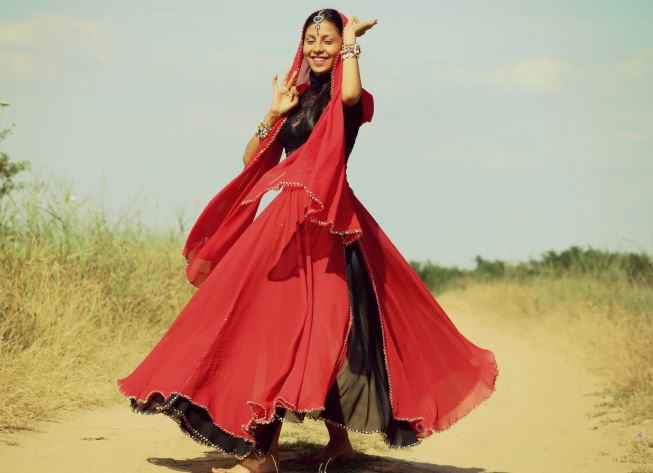Tripura, a land of rich culture and tribal diversity, boasts traditional attire that reflects its heritage and artistry. The state’s clothing is intricately handwoven, showcasing patterns inspired by nature and tribal folklore.
Each garment, from vibrant wrap-around skirts to unisex wraps, carries cultural and historical significance, representing the identity of Tripura’s indigenous communities. These dresses are not just practical for the tropical climate but also eco-friendly, made with natural fibres and dyes.
This blog explores the Top 10 Tripura Traditional Dress, highlighting their unique features, cultural importance, and enduring appeal. Discover how these garments continue to celebrate the spirit of Tripura’s rich traditions.
What Makes Tripura’s Traditional Attire Unique?
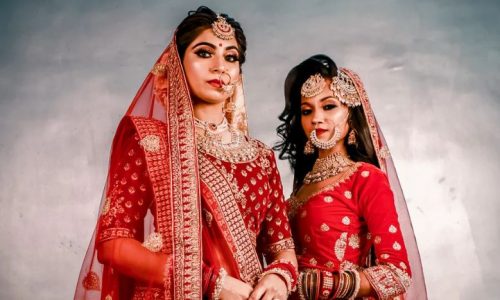
Tripura’s traditional attire stands out for its deep cultural roots and handwoven craftsmanship. The state’s clothing is a reflection of its tribal diversity, with each piece telling a story of heritage, community, and artistry.
These garments are not just practical for the tropical climate but also serve as symbols of identity and pride for the Tripuri people.
The uniqueness lies in the weaving techniques, primarily done on backstrap looms, which create intricate patterns and motifs inspired by nature and tribal folklore. Unlike mass-produced clothing, each piece is handcrafted, showcasing the skill and dedication of the artisans.
Additionally, the use of eco-friendly materials, such as organic cotton and natural dyes, adds to the distinctiveness of these garments, aligning with sustainable practices.
Why Are Weaving Techniques Significant in Tripura’s Culture?
Weaving is an integral part of Tripura’s cultural fabric, literally and metaphorically. The weaving process is a communal activity that preserves traditional knowledge while providing livelihoods for artisans. Passed down through generations, these techniques ensure the authenticity of each garment, making it a treasured piece of art.
The use of backstrap looms allows weavers to produce complex patterns and motifs that carry cultural significance. These motifs often depict tribal folklore, nature, and spirituality, ensuring the garments serve as more than just clothing, they are expressions of the community’s identity.
Moreover, weaving is a symbol of resilience, keeping the traditions alive in a rapidly modernizing world.
How Does Tripura’s Traditional Clothing Contribute to Sustainability?
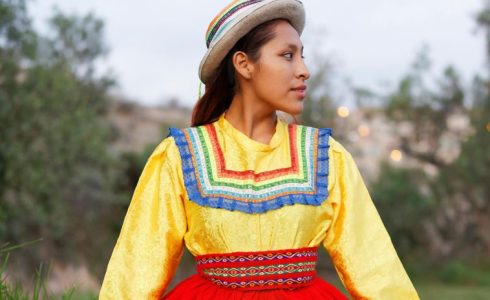
Tripura’s traditional clothing exemplifies sustainable fashion. Most garments are made using natural fibres like cotton and silk, which are locally sourced and biodegradable. The use of natural dyes derived from plants and minerals further reduces environmental impact.
The production process is largely manual, relying on handlooms and traditional weaving techniques. This not only minimizes carbon footprints but also supports local artisans, ensuring fair wages and preserving traditional crafts. By avoiding synthetic materials and mass production, Tripura’s clothing aligns with global efforts to promote eco-consciousness in fashion.
Additionally, the durability of these garments reduces the need for frequent replacements, making them a practical and sustainable choice. This balance of tradition and eco-consciousness underscores Tripura’s commitment to preserving its cultural and environmental heritage.
How Are Tripura’s Traditional Garments Being Modernized?
Traditional Tripuri garments are evolving to appeal to contemporary tastes while retaining their cultural essence. Designers are integrating traditional patterns and fabrics into modern silhouettes like dresses, skirts, and jackets, making them versatile for casual and formal wear.
Younger generations are embracing these modernized styles, blending traditional motifs with global trends. The use of lighter fabrics and minimalistic designs ensures these garments remain practical and stylish. Accessories inspired by traditional attire, such as scarves or stoles with tribal patterns, are also gaining popularity.
Technology and e-commerce are playing a significant role in this transformation. Online platforms are helping artisans reach global markets, increasing demand for traditional Tripuri clothing. This modernization ensures that the heritage of Tripura remains relevant and celebrated while creating new opportunities for its artisans.
Top 10 Tripura Traditional Dress
Rignai: The Iconic Women’s Attire
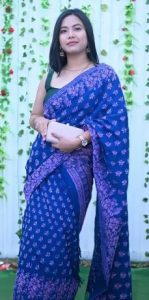
Image – Source
The Rignai is the quintessential traditional dress for women of the Tripuri tribes. This handwoven garment reflects the community’s artistic skill and cultural ethos. Each piece is a masterpiece featuring vibrant patterns like stripes, checks, or geometric designs, often signifying cultural stories and traditions.
The Rignai is not just a garment but a cultural artifact passed down through generations, symbolizing unity and pride within the community.
It is predominantly made from eco-friendly, handwoven cotton, sometimes embellished with silk for ceremonial purposes.
The versatile design makes it suitable for daily wear and elaborate celebrations, such as the Garia Puja and weddings. Its bright color palette, often combining red, green, and black, resonates with the rich cultural landscape of Tripura.
Rignai Dress Details
| Feature | Details |
| Dress Name | Rignai |
| Cultural Significance | Worn by women of the Tripuri tribes as a symbol of cultural pride and identity, often associated with traditional rituals and ceremonies. |
| Fabric & Textiles | Traditionally woven from cotton, with modern variations incorporating silk or synthetic blends for formal occasions. |
| Design Features | Features vibrant stripes, checks, or geometric patterns, often adorned with intricate hand-woven motifs representing Tripuri culture. |
| Color Palette | Bright and bold colours like red, black, green, and yellow dominate, often combined with neutral shades for contrast. |
| Wearing Style | Wrapped around the waist as a skirt, secured with a belt or tucked, and paired with a blouse or “Risa” (a matching upper garment). |
| Occasions for Use | Worn daily by tribal women, elaborately designed Rignai is used during festivals like Garia Puja, weddings, and traditional dance performances. |
| Accessories | Often paired with silver or beaded jewellery, including necklaces, earrings, and bangles that reflect tribal craftsmanship. |
| Craftsmanship | Handwoven on traditional looms by skilled artisans, showcasing the rich textile artistry of the Tripuri community. |
| Cultural Importance | A vital part of Tripuri heritage, symbolizing cultural unity and passed down through generations as a tradition. |
| Modern Variations | Contemporary versions include lighter fabrics and fusion designs to suit modern tastes, making Rignai versatile for casual and formal wear. |
| Embroidery and Zari Work | Embroidery is not common, but some modern adaptations feature decorative elements; zari work is rare to preserve traditional simplicity. |
| Traditional Weaving Techniques | Created using backstrap looms and handwoven techniques, ensuring each piece is unique and reflective of local traditions. |
| Historical Legacy | Rignai holds historical significance as a marker of tribal identity, evolving while maintaining its core traditional essence. |
| Environmental Sustainability | Woven uses eco-friendly materials and practices, including organic cotton and natural dyes, to promote sustainable production. |
| Symbol of Tripura Identity | Represents the diverse tribal cultures of Tripura and is a prominent symbol of the state’s heritage in cultural events. |
| Enduring Popularity | Remains a staple garment for women in Tripura, celebrated for its cultural relevance and timeless appeal. |
2. Risa: A Symbol of Elegance and Functionality
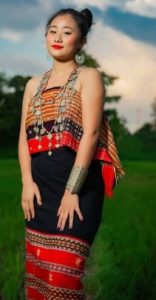
Image – Source
The Risa is more than a piece of cloth for Tripuri women; it is a vital element of their traditional ensemble. Typically worn as a headgear or a shawl, the Risa complements the Rignai, creating a harmonious and culturally rich attire. Its intricate weaving and vibrant hues make it a standout piece in traditional wardrobes.
Handwoven from premium cotton, the Risa reflects the craftsmanship of Tripuri artisans. While its primary purpose is aesthetic, the Risa also holds cultural and ceremonial significance. Women often use it during rites of passage or festivals, further embedding its role in Tripuri traditions.
Risa Dress Details
| Feature | Details |
| Dress Name | Risa |
| Cultural Significance | A versatile garment used as a shawl or headgear, symbolizing cultural pride and worn during festivals, ceremonies, and special events. |
| Fabric & Textiles | Made of handwoven cotton, with occasional use of silk for formal events. |
| Design Features | Typically showcases bold patterns, often matching or complementing the design of the Rignai. |
| Color Palette | Dominated by bright colours like red, yellow, and green, with complementary neutral tones. |
| Wearing Style | Draped over the shoulder, tied as a headscarf, or used as a blouse-like garment when paired with Rignai. |
| Occasions for Use | Seen during Garia Puja, weddings, and other cultural festivities. |
| Accessories | Paired with tribal jewellery for festive occasions or worn simply for daily use. |
| Craftsmanship | Woven by skilled artisans, emphasizing handloom traditions and unique patterns. |
| Cultural Importance | Represents the Tripuri heritage and is a symbol of unity among tribal communities. |
| Modern Variations | Adapted for use as stoles, scarves, or accessories in contemporary fashion. |
| Embroidery and Zari Work | Rarely features embroidery, staying true to its traditional simplicity. |
| Traditional Weaving Techniques | Made on handlooms, emphasizing sustainability and the preservation of age-old practices. |
| Historical Legacy | A timeless garment that has remained a significant part of Tripura’s cultural identity. |
| Environmental Sustainability | Often made using natural dyes and sustainable practices, promoting eco-conscious fashion. |
| Symbol of Tripura Identity | A vital part of the cultural attire, symbolizing the rich heritage and traditions of the state. |
| Enduring Popularity | Continues to be a cultural and fashionable piece embraced by both traditionalists and modern fashion enthusiasts. |
3. Rikutu Gamcha: The Everyday Men’s Wear
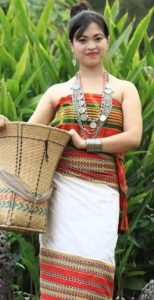
Image – Source
The Rikutu Gamcha is a lightweight, multifunctional cloth traditionally worn by the men of Tripura. It is a staple in daily wear, offering comfort and practicality in the state’s warm and humid climate.
Beyond its utility, the Rikutu Gamcha carries cultural significance, often adorned with simple yet elegant patterns that reflect the modesty and resilience of the Tripuri people.
This handwoven cloth is primarily made from cotton and is known for its durability and breathability. Its understated patterns, usually in earthy or muted tones, align with the natural beauty of Tripura. Whether worn during work, ceremonies, or festivals, the Rikutu Gamcha remains a defining element of men’s traditional attire.
Rikutu Gamcha Dress Details
| Feature | Details |
| Dress Name | Rikutu Gamcha |
| Cultural Significance | Commonly used by Tripuri men as a functional garment for daily tasks and an essential item during festivals and religious ceremonies. |
| Fabric & Textiles | Handwoven from cotton, ensuring breathability and comfort in warm climates. |
| Design Features | Simple geometric or striped patterns that symbolize traditional simplicity and resilience. |
| Color Palette | Dominated by earthy and muted tones like white, beige, and light blue, with occasional brighter hues for festive versions. |
| Wearing Style | Worn as a drape over the shoulder or tied around the waist, depending on the occasion or purpose. |
| Occasions for Use | Ideal for daily use, ceremonies, and cultural events like tribal festivals. |
| Accessories | Often paired with traditional sandals and a simple headgear for cultural events. |
| Craftsmanship | Crafted using traditional weaving techniques by local artisans. |
| Cultural Importance | Represents the hardworking spirit and simplicity of the Tripuri men. |
| Modern Variations | Contemporary adaptations include finer fabrics for use as scarves or stoles in urban settings. |
| Embroidery and Zari Work | Rarely features embroidery, as simplicity is a hallmark of its design. |
| Traditional Weaving Techniques | Made using traditional looms, emphasizing minimal environmental impact and sustainability. |
| Historical Legacy | Symbolic of the humble lifestyle of Tripura’s tribal communities, passed down as a cultural tradition. |
| Environmental Sustainability | Woven with organic cotton and eco-friendly practices, aligning with sustainable textile production. |
| Symbol of Tripura Identity | A cultural staple for men, embodying the traditions and identity of the state. |
| Enduring Popularity | Continues to be widely used, both in traditional settings and for modern purposes. |
4. Kamchwlwi Borok: The Versatile Unisex Garment
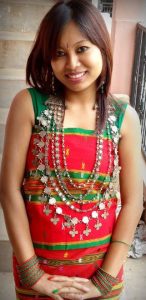
Image – Source
The Kamchwlwi Borok is a unique unisex garment that has been an integral part of Tripura’s tribal attire for centuries. Recognized for its rich history, this wrap-around dress is celebrated for its versatility, serving as formal attire for cultural events and daily wear alike.
The Kamchwlwi Borok is crafted using handwoven cotton and features minimalist designs that exude elegance. Its adaptability ensures it is cherished by both men and women, symbolizing cultural unity among Tripura’s diverse tribes. Worn during religious ceremonies and festivals, the garment highlights the deep spiritual and cultural roots of the Tripuri people.
Kamchwlwi Borok Dress Details
| Feature | Details |
| Dress Name | Kamchwlwi Borok |
| Cultural Significance | A traditional unisex garment symbolizing unity and worn during important cultural and religious events. |
| Fabric & Textiles | Made from handwoven cotton, with occasional use of silk blends for special occasions. |
| Design Features | Minimalist patterns, often with borders or stripes, reflecting understated elegance. |
| Color Palette | Includes neutral shades like white, beige, and grey, with subtle accents of brighter colors for festive wear. |
| Wearing Style | Draped around the body and secured with a belt or tucked, depending on gender and occasion. |
| Occasions for Use | Popular during religious ceremonies, tribal festivals, and as daily wear among elders. |
| Accessories | Paired with traditional ornaments or simple footwear for cultural events. |
| Craftsmanship | Handwoven on traditional looms, showcasing the artisanal skills of the Tripuri community. |
| Cultural Importance | Represents the spiritual and cultural unity of Tripura’s tribes. |
| Modern Variations | Contemporary adaptations include stylish designs for younger generations. |
| Embroidery and Zari Work | Embroidery is rare, with emphasis on traditional simplicity and authenticity. |
| Traditional Weaving Techniques | Woven using eco-friendly looms and hand techniques, ensuring cultural preservation. |
| Historical Legacy | Holds a rich historical connection to the rituals and customs of Tripura’s indigenous people. |
| Environmental Sustainability | Produced with natural fibers and dyes, promoting an eco-conscious approach to clothing. |
| Symbol of Tripura Identity | A cultural emblem representing tradition, simplicity, and unity. |
| Enduring Popularity | Maintains its relevance as a timeless and versatile garment. |
5. Pachra: The Elegant Wrap-Around for Women
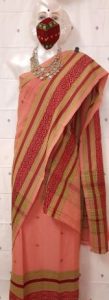
Image – Source
The Pachra is a traditional wrap-around garment primarily worn by Tripuri women. It is recognized for its intricate handwoven patterns and natural dyes that showcase the artistry of the community. Worn daily by women of all ages, the Pachra also plays a significant role in festivals and ceremonies.
The Pachra features lightweight cotton fabric, ensuring comfort in Tripura’s tropical climate. Its striking designs, often incorporating geometric motifs, reflect the cultural narratives of the tribes. Whether worn casually or during special occasions, the Pachra remains a symbol of grace and tradition among Tripuri women.
Pachra Dress Details
| Feature | Details |
| Dress Name | Pachra |
| Cultural Significance | Represents femininity and grace, worn by women in daily life and during cultural festivals like Garia Puja. |
| Fabric & Textiles | Woven from fine cotton threads; some ceremonial versions use silk blends for added elegance. |
| Design Features | Features bold geometric patterns and traditional tribal motifs, representing cultural stories. |
| Color Palette | A mix of bright and earthy tones, often including red, black, and green with contrasting neutral shades. |
| Wearing Style | Wrapped around the lower body as a skirt, often paired with a matching top or Risa. |
| Occasions for Use | Daily wear for women; elaborate designs are reserved for weddings, dances, and religious events. |
| Accessories | Paired with silver or tribal jewelry to enhance the overall look during festive occasions. |
| Craftsmanship | Handwoven by women artisans on traditional looms, preserving age-old weaving techniques. |
| Cultural Importance | Symbolizes the deep connection of Tripuri women to their heritage and traditions. |
| Modern Variations | Contemporary adaptations include lighter fabrics and smaller motifs for modern aesthetics. |
| Embroidery and Zari Work | Embroidery is uncommon to maintain the garment’s authentic and simple nature. |
| Traditional Weaving Techniques | Produced using backstrap looms, ensuring each Pachra is a unique work of art. |
| Historical Legacy | A historical symbol of the Tripuri woman’s identity, woven with cultural narratives passed down through generations. |
| Environmental Sustainability | Created using natural dyes and organic cotton, aligning with sustainable textile practices. |
| Symbol of Tripura Identity | Celebrates the artistic heritage and craftsmanship of Tripura’s women. |
| Enduring Popularity | Remains a cherished garment in both traditional and modern Tripuri wardrobes. |
6. Leepa: A Traditional Wrap for Men
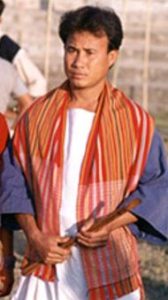
Image – Source
The Leepa is a traditional men’s garment in Tripura, primarily worn during festivals and daily routines. Known for its simplicity and practicality, the Leepa is a rectangular piece of fabric draped around the lower body, much like a sarong.
Typically handwoven from cotton, the Leepa reflects the understated elegance of Tripuri tribal attire. While it is a common sight during casual activities, its formal versions are used in ceremonies, embodying a blend of functionality and tradition.
Leepa Dress Details
| Feature | Details |
| Dress Name | Leepa |
| Cultural Significance | An essential part of daily and ceremonial wear for men, symbolizing simplicity and cultural roots. |
| Fabric & Textiles | Handwoven cotton fabric offering breathability and durability for everyday use. |
| Design Features | Minimalistic patterns, such as stripes or solid colours, emphasise practicality. |
| Color Palette | Muted tones like beige, white, and brown, with occasional brighter shades for festive versions. |
| Wearing Style | Wrapped around the waist and secured with a knot, much like a lungi. |
| Occasions for Use | Worn daily and during traditional ceremonies or rituals. |
| Accessories | Paired with a simple shirt or bare upper body, depending on the context. |
| Craftsmanship | Crafted by local artisans using traditional handlooms, promoting the weaving heritage of Tripura. |
| Cultural Importance | Highlights the simplicity and adaptability of Tripuri men’s attire. |
| Modern Variations | Introduced in modern fabrics for casual wear or reinterpreted as scarves in contemporary fashion. |
| Embroidery and Zari Work | Rarely features embroidery, maintaining its traditional focus on simplicity. |
| Traditional Weaving Techniques | Created using backstrap looms, ensuring eco-friendly and artisan-made production. |
| Historical Legacy | Holds cultural significance as a staple in traditional Tripuri men’s attire, preserving heritage across generations. |
| Environmental Sustainability | Woven using sustainable materials and dyes, aligning with environmentally friendly practices. |
| Symbol of Tripura Identity | Embodies the daily life and customs of the Tripuri community. |
| Enduring Popularity | Continues to be widely used in rural and ceremonial settings, celebrated for its practicality and tradition. |
7. Puanchei: The Festive Skirt
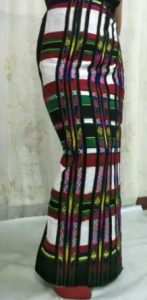
Image – Source
The Puanchei is a richly embroidered skirt traditionally worn by Tripuri women during special occasions. Known for its vibrant colours and intricate designs, the Puanchei is a symbol of joy and celebration. It plays a key role in dances and cultural events, where its flowing patterns enhance the aesthetic appeal of the performances.
Woven with fine threads and often embellished with decorative patterns, the Puanchei is a labour-intensive garment that reflects the craftsmanship of Tripuri artisans. Its bold colours, like red, green, and gold, make it a standout piece during weddings, festivals, and rituals.
Puanchei Dress Details
| Feature | Details |
| Dress Name | Puanchei |
| Cultural Significance | Worn by women during traditional dances, weddings, and festivals, symbolizing joy and festivity. |
| Fabric & Textiles | Made from finely woven cotton, sometimes accented with silk threads for a luxurious finish. |
| Design Features | Features intricate patterns and bold embroidery, often inspired by tribal art and nature. |
| Color Palette | Vibrant shades like red, green, and yellow dominate, complemented with gold or white accents. |
| Wearing Style | Wrapped as a skirt and paired with a blouse or Risa for a complete traditional look. |
| Occasions for Use | Popular during cultural events, traditional dance performances, and community celebrations. |
| Accessories | Enhanced with tribal jewellery like bangles, earrings, and necklaces to complete the festive look. |
| Craftsmanship | Handcrafted by skilled weavers, often taking weeks to produce due to the detailed embroidery. |
| Cultural Importance | Represents the cultural artistry and joyous spirit of the Tripuri tribes. |
| Modern Variations | Adapted into skirts or dresses for contemporary fashion, appealing to younger generations. |
| Embroidery and Zari Work | Embroidery is a defining feature, with occasional use of zari to enhance the festive appeal. |
| Traditional Weaving Techniques | Created using handlooms, preserving the artisanal heritage of Tripura. |
| Historical Legacy | A historical garment associated with celebrations, passed down as part of Tripuri women’s legacy. |
| Environmental Sustainability | Woven using eco-friendly materials and natural dyes, reflecting sustainable production values. |
| Symbol of Tripura Identity | A hallmark of Tripuri festivals and ceremonies, showcasing the vibrant culture of the state. |
| Enduring Popularity | Continues to be a must-have attire for special occasions, celebrated for its cultural and aesthetic appeal. |
8. Chador: A Versatile Wrap for Women
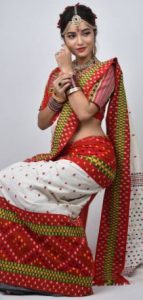
Image – Source
The Chador is a traditional draped cloth worn by Tripuri women, known for its elegance and functionality. This versatile piece serves as both a practical garment and a statement of cultural pride. Its flowing fabric and intricate patterns make it suitable for daily wear and special occasions.
The Chador is typically handwoven from fine cotton and features bold patterns or delicate embroidery. Its adaptability allows it to be styled in multiple ways, including as a headscarf or body wrap. Women often wear it during ceremonies or to add a touch of tradition to their everyday attire.
Chador Dress Details
| Feature | Details |
| Dress Name | Chador |
| Cultural Significance | A multipurpose garment used as a wrap, headscarf, or shawl, symbolizing grace and tradition. |
| Fabric & Textiles | Woven from lightweight cotton, ensuring comfort and breathability. |
| Design Features | Patterns range from simple stripes to intricate tribal motifs, reflecting cultural narratives. |
| Color Palette | Neutral and earthy tones dominate, with occasional use of vibrant hues for festive occasions. |
| Wearing Style | Draped over the body, head, or shoulders, depending on the occasion and wearer’s preference. |
| Occasions for Use | Ideal for daily wear, religious ceremonies, and community gatherings. |
| Accessories | Paired with silver ornaments and tribal jewellery to enhance its traditional appeal. |
| Craftsmanship | Woven on handlooms by local artisans, preserving the cultural artistry of Tripura. |
| Cultural Importance | Represents the resourcefulness and grace of Tripuri women, highlighting their cultural identity. |
| Modern Variations | Adapted for use as stoles or scarves in modern fashion trends. |
| Embroidery and Zari Work | Some versions feature delicate embroidery for ceremonial purposes, but simplicity is often preferred. |
| Traditional Weaving Techniques | Handwoven using backstrap looms, ensuring authenticity and eco-conscious production. |
| Historical Legacy | Holds a special place in Tripura’s textile history as a symbol of versatility and tradition. |
| Environmental Sustainability | Made using organic cotton and natural dyes, reflecting a sustainable approach to fashion. |
| Symbol of Tripura Identity | A traditional staple that represents the elegance and practicality of Tripuri women’s attire. |
| Enduring Popularity | Remains a cherished garment, embraced for its cultural and modern versatility. |
9. Rabung: The Modest Men’s Garment
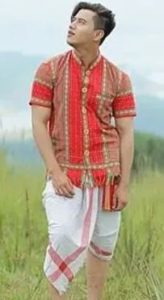
Image – Source
The Rabung is a simple yet traditional wrap-around cloth commonly worn by Tripuri men. Known for its practicality and cultural value, it is a preferred garment for casual and ceremonial purposes. The Rabung exemplifies the minimalist aesthetic of Tripura’s tribal attire, offering comfort and ease of movement.
Woven from cotton, the Rabung typically features modest patterns, such as stripes or checks, that symbolize the humility and grounded nature of the wearer. It is often paired with a plain upper garment or worn bare-chested during rituals, making it an integral part of Tripura’s cultural identity.
Rabung Dress Details
| Feature | Details |
| Dress Name | Rabung |
| Cultural Significance | A symbol of modesty and simplicity, worn by Tripuri men during rituals, festivals, and daily life. |
| Fabric & Textiles | Handwoven from cotton, offering breathability and comfort in tropical climates. |
| Design Features | Characterized by subtle patterns like stripes or checks, emphasizing practicality over ornamentation. |
| Color Palette | Muted colours such as white, beige, and light brown are occasionally accented with darker hues for festive versions. |
| Wearing Style | Draped around the waist and secured with a knot, often complemented by a plain upper garment. |
| Occasions for Use | Suitable for daily wear, community gatherings, and traditional ceremonies. |
| Accessories | Typically worn with simple headgear or sandals, reflecting the minimalist aesthetic. |
| Craftsmanship | Crafted by local artisans using handloom techniques, ensuring a unique and high-quality finish. |
| Cultural Importance | Represents the resourceful and humble lifestyle of the Tripuri men. |
| Modern Variations | Reinterpreted as casual wear or scarves in contemporary fashion trends. |
| Embroidery and Zari Work | Rarely incorporates embellishments, focusing instead on its utilitarian design. |
| Traditional Weaving Techniques | Made on traditional looms using eco-friendly materials and practices. |
| Historical Legacy | Reflects the historical importance of simplicity in Tripura’s tribal attire. |
| Environmental Sustainability | Produced with organic cotton and natural dyes, promoting sustainable fashion practices. |
| Symbol of Tripura Identity | A key garment reflecting the daily life and traditions of the Tripuri community. |
| Enduring Popularity | Continues to be a preferred choice for both traditional and modern uses, celebrated for its timeless appeal. |
10. Borok Ethnic Wrap: A Symbol of Tribal Unity
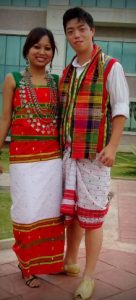
Image – Source
The Borok Ethnic Wrap is a culturally significant garment worn by both men and women in Tripura. Known for its elaborate patterns and symbolic motifs, the wrap represents the shared heritage and unity among the state’s tribes.
Traditionally woven from natural fibres, the Borok Wrap features bold designs and vibrant colours, making it suitable for festivals, ceremonies, and cultural events. Its versatility allows it to be styled in various ways, reflecting the creativity and adaptability of Tripuri culture.
Borok Ethnic Wrap Details
| Feature | Details |
| Dress Name | Borok Ethnic Wrap |
| Cultural Significance | A unisex garment symbolizing tribal unity and worn during cultural festivals and ceremonies. |
| Fabric & Textiles | Handwoven from organic cotton or silk, emphasizing eco-friendly practices. |
| Design Features | Bold tribal motifs and intricate patterns, representing cultural narratives and traditions. |
| Color Palette | Vibrant colours like red, yellow, and green dominate, often combined with neutral tones for balance. |
| Wearing Style | Draped around the body in various styles, depending on gender and occasion. |
| Occasions for Use | Popular during tribal festivals, religious ceremonies, and community events. |
| Accessories | Paired with tribal jewellery or headgear for ceremonial purposes. |
| Craftsmanship | Woven by skilled artisans using traditional looms, showcasing the artistry of Tripura’s tribes. |
| Cultural Importance | Represents the unity and shared heritage of Tripura’s diverse tribal communities. |
| Modern Variations | Contemporary versions include scarves or shawls inspired by traditional designs. |
| Embroidery and Zari Work | Occasionally features embroidery or embellishments, especially for festive versions. |
| Traditional Weaving Techniques | Made using handlooms, ensuring each piece is unique and environmentally friendly. |
| Historical Legacy | Holds historical significance as a cultural emblem of Tripura’s tribal identity. |
| Environmental Sustainability | Produced with natural fibres and dyes, reflecting the state’s commitment to sustainable textiles. |
| Symbol of Tripura Identity | Celebrates the shared traditions and artistry of the Tripuri people. |
| Enduring Popularity | It remains a staple in cultural celebrations and is admired for its versatility and traditional appeal. |
Conclusion
Tripura’s traditional dresses symbolize the essence of its tribal heritage, blending functionality with artistic expression. These garments, woven with skill and cultural pride, continue to be a vital part of the state’s identity.
From the intricate patterns of women’s attires to the simplicity of men’s wraps, each dress tells a story of tradition, sustainability, and craftsmanship.
As modern adaptations bring these timeless pieces to a broader audience, Tripura’s cultural attire remains relevant while preserving its roots.
Embracing these traditional garments means supporting artisans and celebrating the rich legacy of this culturally vibrant state.
FAQs
What is the most popular traditional dress of Tripura?
The Rignai and Risa are among the most popular traditional dresses, symbolizing the cultural identity of Tripuri women.
What materials are used in Tripura’s traditional attire?
Cotton is the primary material, with occasional use of silk or synthetic blends for ceremonial garments.
Are traditional Tripuri dresses sustainable?
Yes, they are eco-friendly, often made with organic cotton and natural dyes using sustainable weaving practices.
What is the significance of Kamchwlwi Borok?
Kamchwlwi Borok is a unisex garment that symbolizes unity and is often worn during cultural and religious events.
Where can one buy authentic Tripura traditional dresses?
These dresses are available in local markets in Tripura and through online platforms specializing in ethnic wear.
Do younger generations still wear traditional Tripuri attire?
Yes, younger generations incorporate traditional designs into modern styles, keeping the heritage alive.
How are these garments preserved as part of Tripura’s culture?
The government and tribal communities work together to promote handloom weaving and traditional designs through fairs and exhibitions.

